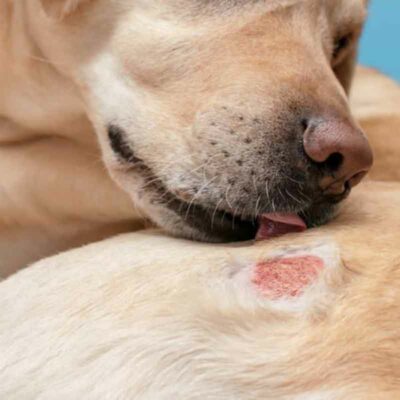 Skin disorders in dogs
Skin disorders in dogs
Dog skin issues rank high among concerns prompting pet owners to seek veterinary care. Observable anomalies like incessant scratching, redness, inflammation, hair loss, and the emergence of lumps and bumps may signal various canine skin conditions—from allergies, fleas, and ticks to infections and mange.
When you notice any deviation in your dog’s skin health, consulting a vet is imperative to secure the appropriate treatment. Beyond potential discomfort, untreated mild skin problems can escalate into more severe issues.
Manifestations of skin conditions in dogs vary, mirroring the diversity seen in human skin ailments. Key indicators that your dog might be grappling with a skin issue include persistent scratching, self-biting, and visible signs of irritation, such as redness. Additional cues encompass hair loss, flaky skin, changes in skin texture, scabs, lumps, and an unusual or unpleasant odor.
Given the broad spectrum of conditions linked to these symptoms, pinpointing the precise issue can be challenging without professional guidance. If your dog exhibits any of these signs, reaching out to your vet promptly is advised. This initiates the crucial steps of diagnosis and tailored treatment, ensuring your furry companion’s skin health is restored.
1. Skin Allergies in Dogs
Skin allergies, often coined as allergic dermatitis, stand out as the top allergic concern for our beloved canine companions. The telltale signs of incessant itching, scratching, and general discomfort might indicate a variety of irritants bothering your furry friend.
Most common causes of skin allergies in dogs
- Flea Allergy Dermatitis
The saliva of fleas can trigger allergic reactions in some dogs, leading to flea allergy dermatitis. This often manifests as intense itching, particularly around the base of the tail. Watch out for red, inflamed skin with scabbing. Signs of fleas may include flea dirt and occasionally spotting the fleas themselves. - Food Allergies
Itchy skin in your pet could be a result of food allergies or sensitivities. Keep an eye out for scratching at paws or ears, alongside potential gastrointestinal symptoms like vomiting or diarrhea. Distinguishing between allergies and sensitivities is crucial; sensitivities develop gradually, while true allergies prompt immediate immune responses, leading to conditions like facial swelling and hives. - Environmental Allergens
Atopic dermatitis, triggered by environmental allergens such as mold, pollen, and dust, can pose a challenge for your dog. Seasonal allergies may also come into play, affecting your furry friend only during specific times of the year. Check paws, ears, muzzle, eyes, wrists, underarms, ankles, and between toes for signs of environmental allergies.
Common symptoms of Skin Allergies in dogs
- Excessive scratching
- Excessive licking
- Rubbing of ears or face
- Biting or chewing the skin
- Rubbing or scooting on surfaces
- Red, irritated, or flaky skin
- Sores
- Hair loss
Severe skin allergies not only bring discomfort and itching but also carry the risk of secondary infections. Constant scratching, licking, and biting may create openings for yeast and bacterial infections. These complications may necessitate specialized treatment to ensure your canine companion’s well-being.
2. Acanthosis Nigricans (Hyperpigmentation) in dogs
Acanthosis nigricans, characterized by hyperpigmentation of a dog’s skin, can manifest as either a secondary stage of another skin disease or as an inherited condition. The inherited form is predominantly observed in dachshunds, typically surfacing by their first birthday. Conversely, the secondary disorder can affect any breed at any age.
Causes of Acanthosis Nigricans
The origins of the inherited form remain unclear in veterinary science, with suggestions of autosomal recessive or polygenic inheritance.
Polygenic inheritance involves the control of a condition or trait by two or more genes, while autosomal recessive inheritance means a dog with acanthosis nigricans inherited two defective genes.
In contrast, those with one defective gene act as carriers. Breeds prone to developing the condition as a secondary disorder often exhibit tendencies for skin inflammation in specific areas like the groin, leg folds, trunk, obesity, dermatitis, underactive thyroid, and food allergies.
Typically, the condition manifests as darkened skin in leg creases or the groin, progressing to hair loss and the formation of dark, leathery patches. These patches may become inflamed and worsen if left untreated, potentially leading to yeast or bacterial infections, accompanied by itching that exacerbates the skin problem. Additionally, these patches can emit odors and cause discomfort for your furry friend.
Diagnosis of Acanthosis Nigricans
While veterinarians can readily identify the disease, a comprehensive examination and history-taking are crucial, especially for dogs acquiring acanthosis nigricans as a secondary condition. Skin scrapings, thyroid and adrenal function tests, and food allergy assessments may be conducted. Inherited cases, however, rely more on the characteristic appearance for diagnosis.
Treatment of Hyperpigmentation in Dogs
For dogs with inherited acanthosis nigricans, a complete cure is elusive, but effective management includes anti-seborrheic shampoo, vitamin E oil, melatonin, and corticosteroids as needed, with a prescribed treatment plan from your vet. Dogs with acquired conditions benefit from antimicrobial shampoo and vet-prescribed topical ointments. A regimen of melatonin, vitamin E, and systemic glucocorticoids may also be suggested, gradually resolving the condition over several months.


